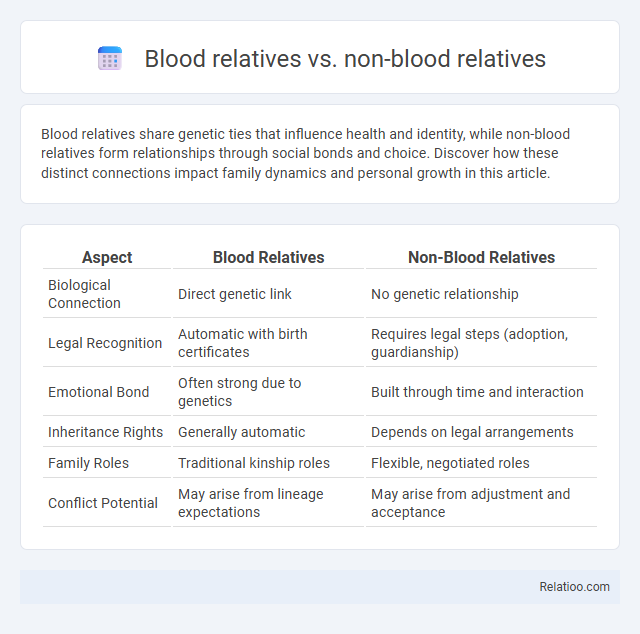Blood relatives share genetic ties that influence health and identity, while non-blood relatives form relationships through social bonds and choice. Discover how these distinct connections impact family dynamics and personal growth in this article.
Table of Comparison
| Aspect | Blood Relatives | Non-Blood Relatives |
|---|---|---|
| Biological Connection | Direct genetic link | No genetic relationship |
| Legal Recognition | Automatic with birth certificates | Requires legal steps (adoption, guardianship) |
| Emotional Bond | Often strong due to genetics | Built through time and interaction |
| Inheritance Rights | Generally automatic | Depends on legal arrangements |
| Family Roles | Traditional kinship roles | Flexible, negotiated roles |
| Conflict Potential | May arise from lineage expectations | May arise from adjustment and acceptance |
Understanding Blood Relatives: Definition and Types
Blood relatives are individuals connected by genetic ties, including immediate family members such as parents, siblings, and children, as well as extended relatives like cousins, aunts, uncles, and grandparents. The genetic linkage is significant for inheritance patterns, medical histories, and biological traits, distinguishing blood relatives from non-blood relatives like stepfamily members or close family friends. Understanding the types of blood relatives aids in legal contexts, genealogy research, and assessing hereditary health risks within family studies.
Who Are Non-Blood Relatives? Expanding the Family Circle
Non-blood relatives include in-laws, stepfamily members, close family friends, and godparents who contribute significantly to the family dynamic despite lacking a biological connection. Your family bond extends beyond genetics through shared experiences, emotional support, and mutual commitment, creating strong, meaningful relationships. Expanding the family circle with non-blood relatives enriches your social network and fosters a diverse support system.
Key Differences Between Blood and Non-Blood Relationships
Blood relatives share genetic links, often influencing inheritance, medical history, and biological traits, while non-blood relatives form connections through marriage, adoption, or close social bonds without genetic ties. Family bonds in non-blood relationships can be equally strong, emphasizing emotional support, trust, and shared experiences rather than genetic connection. Understanding these key differences highlights that familial strength derives from both biology and emotional commitment.
The Role of Genetics in Blood Relationships
Genetics plays a central role in defining blood relatives, as shared DNA contributes to biological connections that influence traits, health predispositions, and inherited characteristics. Non-blood relatives, while not linked by genetics, can form equally strong family bonds through emotional support, shared experiences, and social connections. The family bond transcends genetic ties by encompassing love, trust, and commitment, highlighting that familial relationships are shaped by both biology and interpersonal dynamics.
Legal Perspectives: Rights of Blood vs. Non-Blood Relatives
Legal perspectives distinguish blood relatives as individuals sharing genetic ties, often granting them automatic inheritance rights and decision-making authority in medical or estate matters. Non-blood relatives, such as spouses or legally adopted family members, acquire rights through formal legal recognition but may face challenges without clear documentation. Understanding your specific family bond's legal framework is crucial to securing rights related to custody, inheritance, or healthcare decisions.
Emotional Bonds: Nature vs. Nurture in Family Connections
Emotional bonds within family connections often transcend genetic ties, highlighting the complex interplay between nature and nurture. Blood relatives may share innate biological connections that influence emotional closeness, yet non-blood relatives, such as adopted family members or close friends, frequently develop equally strong or stronger bonds through shared experiences and consistent emotional support. This dynamic illustrates how nurturing relationships and emotional investment can shape deep familial bonds beyond mere genetic relatedness.
Cultural Variations in Defining Family
Cultural variations heavily influence how blood relatives, non-blood relatives, and family bonds are defined and valued across societies. In many cultures, family extends beyond biological ties to include close friends and community members, emphasizing shared responsibilities and emotional connections. Understanding these distinctions allows you to appreciate the diverse ways that family is formed and sustained around the world.
The Impact of Non-Blood Relatives in Blended Families
Non-blood relatives in blended families often play crucial roles in shaping emotional support systems, with step-parents and step-siblings contributing significantly to family cohesion and stability. Research shows that the strength of family bonds in blended households depends more on mutual respect, communication, and shared experiences than on genetic ties. Positive relationships with non-blood relatives can enhance children's psychological well-being and facilitate smoother transitions during family restructuring.
Challenges and Benefits of Non-Blood Family Ties
Non-blood relatives often face unique challenges such as societal skepticism and legal limitations, impacting the legitimacy and recognition of family bonds. Your emotional connection and mutual support within non-blood family ties can offer significant benefits, including chosen loyalty and diverse perspectives. These relationships emphasize that family bonds extend beyond genetics, fostering resilience and belonging despite biological differences.
Redefining Family: Embracing Diverse Relationships
Blood relatives, defined by shared genetics, often carry traditional expectations of loyalty and support, yet non-blood relatives--such as close friends or chosen family--can provide equally strong emotional bonds that redefine the concept of kinship. Your family bond is increasingly recognized as a dynamic connection built on trust, love, and mutual care rather than solely on biological ties. Embracing diverse relationships expands the meaning of family to include anyone who contributes to your sense of belonging and support system.

Infographic: Blood relatives vs Non-blood relatives
 relatioo.com
relatioo.com